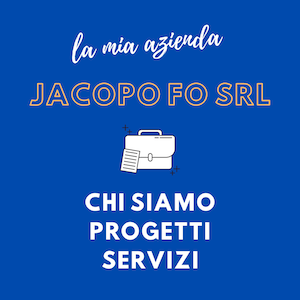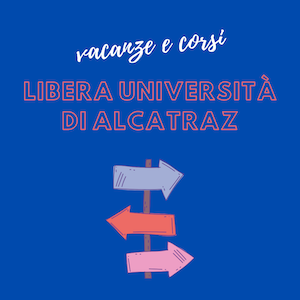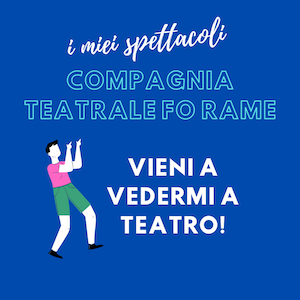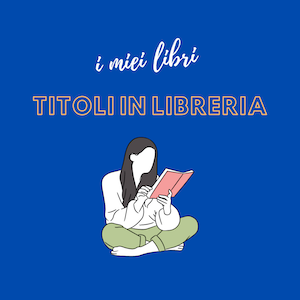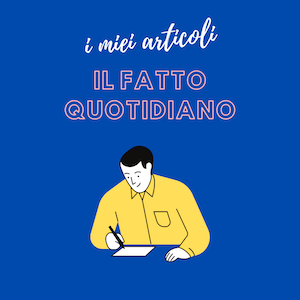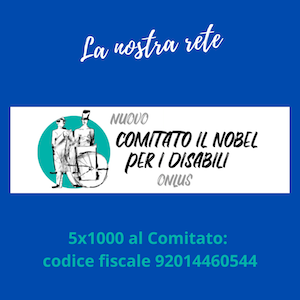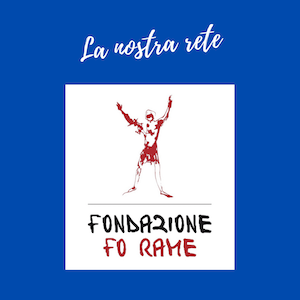by Jacopo Fo
If you look up a history book you’ll find that blacks are the most stupid people in the world. They never invented anything, they cannot boast ancient civilizations, they’ve always been beaten by everyone; Arabs or Europeans indistinctly.
Blacks were people who submitted to centuries of slavery without rebelling whatsoever. They were just so far behind that they couldn’t even invent an alphabet of their own or a style of writing. They’re still dying of starvation because they have no spirit of initiative when it comes to working. And once the colonial regime fell, they started a general massacre killing one another with such a primitive instinct to leave you astonished: millions of dead killed with machetes so as not to waste ammunitions. All we know about black people is that they run fast, they strike hard, they have rhythm and black men have super cocks. Then, then this Obama guy shows up from nowhere and becomes President of the United States.
Leftists like being precise by stating that we are all equal. They even say we all descend from a few black skinned women. Cavalli Sforza proved this through his studies on DNA. Consequently we are all black, therefore racism makes no sense whatsoever. We may want to add that the majority of black people are poor and desperate, may they be living in the heart of Africa or some United States ghetto; poor and desperate not because they don’t know how to work or develop but because colonialism destroyed great African civilizations from the roots by imposing 5 centuries of violence and incredible robberies which left the continent barbarized.
The first thing to be said is that it SEEMS as if black people don’t have a great history and have not been capable of rebellion just because history books had been censored in the past; capably and completely censored. With this article I’ll try to restore a few “essential truths” forgotten along the way. (Laura Malucelli wrote an interesting book on this matter; “Le società matriarcali nere” “Matriarchy in black societies” with particular attention to slavery and black revolts . You can read an extract in “schiave ribelli” “rebelling slaves”. All our ancestors were black. They were the first colonizers of Europe, of Asia, of America and Australia. They gradually lost their “tan” due to the cold weather conditions they were living in. The first settlements along major rivers were black; these people chose to live where the temperature was mild. They started constructing between 7000 and 3500 afore Christ. They possessed an oral tradition of narration and had knowledge of astronomy, mathematics, geometry besides having a great ability in building canals, levees, embankments as well as draining swamps for agriculture. They built homes with chimneys and the doors had hinges. They were very successful copper and goldsmiths and chiseled wonderful stone statues. They integrated daily routine with farming and fishing. They faced oceans on board of tiny canoes built from hollow trunks, and obtained rafts by tying canes together. Their villages had no defensive walls, and in their art and sculptures we find the celebration of the fertility of nature and NOT the celebration of wars or of power.
Their burials were similar for all the members of the community, even women were buried in the same way as men. This shows that men and women were equal and covered equal roles within their social scale; women were not subjugated by men. Besides, an incredible number of erotic images and the representation of breasts and sexual organs indicate a population who preferred celebrating pleasure rather than celebrating conquests and dominations. These societies were defined as matriarchal. Researchers underlined that it was not a condition in which women dominated men but rather a condition of social equity and balance. They coined a new conception, the “partnership society”, where power was equally shared. For more than one and a half centuries the existence of this society was denied by official historiography and those who affirmed the existence of the “partnership society” would be mocked and emarginated. Today we have an enormous quantity of archeological proofs which attest the existence of florid matriarchal societies in China, India, the Middle East and Egypt. They exchanged merchandise and goods with other populations without handing down male casts or war culture. This civilization created a prototype of writing based on ideograms which are identical from Egypt to India. We owe this civilization important, I daresay, fundamental discoveries such as the hammer and the hoe. From the net for fishing to utensils for farming, from pottery to weaving. Up until the year 3500 before Christ we register continuous migrations in the heart of central Africa which expand in all directions. Numerous studies have been made which state that many words used in agriculture nowadays derive from the San languages of Africa.
In the meantime, European-Asian steppes were beginning to bare the first signs of animal breeding such as horses. These populations were obliged to maintain aggressive attitudes due to the need of protecting their flocks from wild animals as well as predators. They improved their warrior qualities thus creating a society of male leaders dominating women. They invented bows and arrows for hunting so as to succeed in capturing and killing large animals or even men and contemporarily learned to tame horses transforming them into important instruments of war. Ever since 3500 before Christ these warriors, who in centuries had changed the color of their skin from “tanned” to pale, whose noses had become narrower and pointier, whose lips had thinned down, these warriors came to know a new demographic explosion made possible by the maturity reached through raising and breeding of animals. Pushed into looking for new lands due to over population as a consequence to breeding, these warriors migrated towards fertile lands inhabited by black fishermen living within matriarchal societies. These migrations have been demonstrated by the researcher Marija Gimbutas, proven through archeological findings as well as Cavalli Sforza’s considering DNA analysis and linguistic tracks. (See Marija Gimbutas “Il Linguaggio della Dea”, “The Language of the Goddess”, published by Neri Pozza and Luigi Luca Cavalli-Sforza, Paolo Menozzi, Alberto Piazza “Storia e geografia dei geni umani” “History and geography of human genes” published by Adelphi, Milan in 1977).
The history of the following millenniums is that of conflict between the two cultures. Menes, the first legendary Egyptian pharaoh represented in a famous bas-relief (Narmer table) had straight hair and a very straight nose. He was surrounded by beheaded men with curly hair and flat noses
(http://ancientegypt.wordpress.com/2008/03/07/narmer/).
And still today the majority of very dark skinned, untouchable Indians descend from populations defeated by hordes of white breeders 3000 years ago. And what about the heroic resistance of many farming fishermen who fought off invasions. In fact, we can also find black pharaohs . And in China in the year 1200 a. C where we find a few black emperors belonging to the Shang population which was a mix of people from diverse ethnic groups (should you wish to look up alternative information concerning black civilization groups:
http://www.the7fire.com/black_civilization/glorious_achievements_of_black_c.htm
with particular attention towards the black Shang population:
http://www.afroshanghai.com/blog/?p=6
concerning the hypothesis on black skinned Olmecs:
http://originalblacksofamericabeforecolumbus.blogspot.com)
Third millennium barbarian invasions conquered the Middle East, Europe and North Africa, without penetrating beyond the Sahara region, and for another 4 thousand years the African civilization developed in a flourishing and independent manner. The Arab penetration was extremely slow and only reached a portion of black Africa.
Whilst in Europe people were still living inside caves, African astronomers had traced accurate celestial maps. During the year 1000, in Timbuktu there were far many more books than in London. Africans traded with India and China and great reigns were born. But the must peculiar thing about African history is that for millenniums the populations continued to prosper conserving the major part of their matriarchal culture, developing an extremely efficient social system.
This regarded populations defined as “single mullet”, that is, populations without dominating casts nor kings. All the village members had equal rights and established relationships with neighboring villages in an equal and cooperative way. These populations improved complex social systems covering the interests of all through cooperation. Besides individual vegetable gardens there were also collective vegetable patches used to face possible extraordinary communal needs. And centuries before the first European bank was founded, these populations had already established complex insurance programs against disasters. Such programs contemporarily contained the idea of a bank as well as a public limited company. For example, ten villages would unite and reciprocally invest in one another’s economy raising incomes in good times and diminishing damages in bad times. Every year each and every village donated 10% of it’s harvest to the village most in need which would, consequently, develop it’s own economy. In the following years that very same village would return the initial “loan” received by donating another 10% of a far more abundant harvest. Such systems of cooperation existed before the coming of the white man and have resisted up until today. They are called “tontinas”. These “single mullet” African societies resisted slavery by uniting and combating furious wars which saw them, sometimes, winners. In other cases they withdrew leaving entire regions inhabited, migrating towards impenetrable areas where their existence was safe from slave merchant’s attacks.
When these men and these women were captured they proved to be terrible slaves, slaves of the worst kind, for they would not submit to their condition of slavery. Throughout South America hundreds of slave revolts took place and ex slaves reunited in villages called “quilombos”. Some of these villages expanded and one of them, Palmares in Brazil, resisted for almost an entire century against slave-driver assaults. If you research on the internet you will find plenty of material concerning this subject.
I’m going to tell you one of these stories, the story of a slave rebellion, an almost unknown revolution of groups of thousands of slaves who succeeded in defeating the Portuguese thus saving themselves from slavery. These rebels were called Kalunga.
Slave Maudi is a dangerous guy.
When they arrived in chains within a slave ship, they were far more dead than alive. The Portuguese had already had terrible experiences with those guys, those captured in certain zones. Maudi was dragged in chains, he was dragged underground and obliged to pickaxe rocks in darkness. And not even whilst he was digging did they remove the chains from his wrists because he was black and mean just like all the black and mean men in chains slaving by his side. Portuguese understood that they couldn’t show their back’s to those black slaves because those slaves were particularly crazy. Maudi would dig, eat the shit they’d feed him, and whilst looking at those who had arrived afore, he became fully aware that he didn’t have much time to live. He needed an idea, he needed to find a solution which would allow him to escape the hell he was in, that dark and stinking hell of excrements and gangrene; black people’s skin rotted where chains constantly rubbed against it. Finally and idea did come! After nightly discussions with other slaves, a solution came to mind. They had to rebel, in one way or the other, they had to rebel and kill the guards but how could they do that in chains? The slaves who had most resisted, those who had survived torture and slavery for the majority of time knew that white men, those insane and assassin whites, had a God, a male God which they turned to and honored particularly once a year on the day of His birth. A God who had been immediately killed by other white men; those pale skinned devils who had crucified him on a wooden cross so as to guarantee him a slow and painful death. It was incredible to their eyes, to the slave’s eye, to kill a Divinity especially if it was the only God but the Kalungas came to believe that white people were only capable of killing. The previously mentioned idea consisted in converting to the white man’s religions thus participating to that yearly celebration; the celebration of the Birth of an assassinated God. This would have permitted them to be temporarily freed from their chained condition and….they could have fought and killed their torturers who were, in fact, small and weak and disgusting beings. They’d never had the strength or determination to resist blacks, and most certainly the slaves would have won. So they decided to inform the armed guards (who had guns and shimmering swords) and slave-drivers that they too wished to adore the God of the whites and they swore they would have never again adored Mother Goddess who nurtures all creatures. They asked their jailers to free hands and feet from chained conditions so as to pray the God they had chosen to adore. But the guards with iron helmets said no. So they asked permission for dancing. They wanted to prepare a ritual dance for their new God, a dance of praise and respect for the killed God. The ritual dance would have taken time to be prepared because it’s difficult to dance when you’re in chains. The armed guards finally gave them permission because they, the guards, thought it would be quite a funny sight to see; “wild” men tripping and stumbling on their own chains. And this is how the Kalunga slaves invented Capoeira, a technique apt to “free” you whilst apparently dancing in praise. A combat style done in chains! Once the men were capable enough to coordinate movements they attacked the guards who wore shoes on their feet instead of walking barefoot like the black man. The slaves killed almost everyone and freed approximately thirty thousand men from chains. This happened in the silver mines around the Rio de la Plata. Subsequently they won the army which had been sent to punish them, but this time they fought riding horses, using swords, guns, canons, iron helmets and wearing shoes on their feet, and that very day Maudi was at the head of 200 warriors who were using cannons to defeat the enemy. There was a big discussion because everybody knew that more and more Portuguese soldiers would have arrived, yet they were all aware that those who adore the Great Mother cannot fight. They decided to flee, they decided to find a place to stay where they would have never been found, and precisely in the deepest of forests. It would have been impossible for thirty thousand people to return to Africa. Besides, they were doubtful of what they could have found once home. So they sent the most capable of hunters and the most acknowledged regarding herbs to explore the Amazon forest. An immense undertaking which had to be fulfilled within the shortest of times. Two months passed without any response from the people who had undertaken the exploration, and fortunately still no Portuguese ships could be seen along the shore.
Finally the news; someone had found an ideal location at an approximately twenty days walk. A place which could have hosted all people, a place which would have protected them from military incursions. And so they started to march bringing all they could bring with them, all they could carry on their shoulders and on the horses backs because there were no roads in the place they were moving to. They walked from encampment to encampment. They walked for two years covering more than one thousand kilometers. They walked until they reached rich and flourishing highlands where the climate was gentle and hospitable.
For 250 years the sons of their sons lived on unreachable highlands without ever coming across a white man. Only in 1955 did some researchers find their way through the Amazon straight to where the Kalunga had migrated. Slavery was no longer legal in South America! Today Brazil counts over 2000 quilombos that are inhabited by descendants of the rebel slaves who fought for their rights.
A completely different way of thinking
As previously mentioned, the ancient African civilization carries a different way of thinking and has evolved reaching original and wonderful forms which leave us amazed and astonished in consequence of diversity and distance between their and our worlds, their and our mind structure concerning victory and defeat, dominion and annihilation, vengeance. These experiences prove how poor and violent western culture is concerning ethics. Here’s two illuminating examples:
South Africa: the Courts of Forgiveness.
When the racist regime fell, Nelson Mandela understood that he had to ask his people a difficult question. An impossible question that could never had been asked European countries, probably even incomprehensible to us due to our mental structure. He asked; “what should we do to those who tortured us, who killed us, who kept us in chains, who humiliated us? What should we do to those who killed our fathers, who raped our mothers, our wives, our daughters? What should we do to those dogs that constantly bit at our lives? Are we sure it’s going to be worth killing them, keeping them in prison, punish them?” and this is how the big discussion began. No one doubted that thieves or assassins could be jailed so as to avoid their committing other crimes thus allowing them to undergo a process of rehabilitation, but what about those executioners and their instigators who had tortured an entire nation for more than ten years? It really seemed as if there was no possibility in applying the same kind of reasoning. The crime or crimes were too big, too immense to be punished. After infinite discussions, it was decided to not punish those guilty of the most barbarian and tremendous crimes ever perpetrated in South Africa.
No, I’m not crazy. This is how things really went, and they, the people, behaved the correct way.
These black guys still have a strong component of their ancient matriarchal culture which recognizes the idea of spiritual value, the spiritual value of an experience, and the interconnection between all phenomenas. This culture facilitates the understanding and identification (empathic identification) between victims thus allowing people to comprehend how one can feel when put into a certain situation. If you’ve been subject to violence , even simple vengeance cannot be satisfying for your nature. The horror and disgust you’ve experienced on your own skin , the stigmata of humiliation and memories made of torment and regret will not change through revenge. Even if you kill the person who tortured you, even if you lead him to a slow and painful death, your perception of the horror you’ve gone through will not change. Bantù culture has a concept which is far higher than vengeance itself: the consolation of the victim.
So these people asked themselves what could really change their states of mind and partially redeem the injustices they’d been victims of. They said; “we refuse vengeance as the sole solution for relieving pain and substitute vengeance with understanding.” Pain can be overcome if shared collectively. When the tortured man returns to his village and talks about the 100 times he was whipped, even his friends might ask themselves whether he’s exaggerating. They won’t doubt his being whipped but , was he sure it was 100 times and maybe not 70 times instead? The tortured person wants to be believed for the experience he’s been through and for the entity of the pain undergone. This is the only possible small consolation. The black people’s government decides to create an incredible, legal institute: the Court of Forgiveness. For years they went on hearing people. Victims would introduce themselves and tell their stories explaining all they’d been through and accusing those who had tortured them. Torturers were obliged to go to court and confess their deeds in detail; the crimes they had committed, when and whey they’d committed them. They would receive no punishment whatsoever should they openly admit their deeds. In this way there was evident truth and nobody could or can deny evident truth. No one in South Africa can doubt about the terrible crimes committed in that country because criminals have admitted and confessed their deeds. Declarations have been filmed and transmitted on TV. It took years to list, describe, and prove the entity of crimes committed.
Nowadays people still deny Nazi crimes, Stalinist crimes, Pinochet, Greek or Argentinian colonel’s crimes. This denial is unfortunately tied to the fact that punishments were perpetrated as an act of vengeance, a process which automatically generates a defense that tends to deny or reject responsibilities and faults. And this negation of the horrors of the past, more or latent horrors of the past, sows hatred and insatiable resentments. But beware! Forgiveness is not an action of renouncement but the action of substituting vengeance with the awareness of undergone atrocities.
You cannot react in front of horror. In Yugoslavia, during the second world war, the Nazi Croatian regime exterminated more than a million Serbs. The crime was censured by Tito in name of the national reconciliation. Not facing pain after a genocide of such entity has proven to be far more devastating than facing it with a spirit of vengeance. After a few years the balloon exploded. Journalists who were interviewing Serbian combat squads during ethnic war were quite astonished when hearing soldiers sum the number of dead during the persecutions in the 1940’s. For many Serbians the war had never finished, never since then. It had only been frozen for 50 years.
“How much are you willing to pay to wash the rear-end of a dying man?” I read a story in “Nigrizia” (a combonian missionary magazine), and found it particularly interesting because it told about a self-managed sanitary assistance run by some the world’s poorest farmers. A net of solidarity within a tiny village: these farmers employ there time washing and feeding the sick, alleviating their sufferings by using medical herbs, wild herbs, because medicines do not reach the place they live in.
The magazine published a young girl’s letter addressed to the village committee. More or less it stated as follow; you know me, you know who I am. Many a times you have held me in your arms and when in need, you received my parents too. When they died you took care of me and now I live requiting your hospitality by working in the village vegetable garden . I wish to thank you for all you’ve done for me but I would contemporarily like to ask you a big favor. By biggest dream is that of caring for others, caring for the ill.
As you know, I volunteer in the vegetable garden and am therefore not paid for what I do. For this reason I cannot pay to care for other people. I would like to make a suggestion, an exception to the rules; allow me a double shift in the garden, and in this way I’ll succeed in paying my right to care for other people.
Believe me! When I read this I jumped out of my chair and had to go back and read the article again. I mean there IS a place in the world where a girl implores to pay through an exchange of double volunteering so as to gain the right to cure other people because she doesn’t have the money to do so? But who are these people? The poorest farmers on Earth pay cash, they actually pay their right to cure the sick? Why? Simple, thanks to elements within the matriarchal culture, elements which have survived through centuries, elements which people believe essential such as taking care of death rather than being afraid of it thus censoring it. They believe, they feel that, the fear of death needs to be soothened, that there really is no reason for being afraid of death or of the dying. And these people know something else I unfortunately discovered late in life; I always tried to avoid death as well as relating to people who were dying. I was terrorized by the emotions that these encounters with death could have risen in heart and mind. Then destiny put me into a situation I could neither hide nor run from. To run from it would have been far more painful than to face the terror I had of death. Life gave me the opportunity of finding myself side by side with people of great value who were dying. People of great value don’t die like people who are worth nothing. If you’ve ever spoken to someone who’s dying; someone of inestimable value who’s dying, then you know what I’m talking about. It’s an incredible experience.
I remember when my great-grandmother Matilde died. She was a wonderful great-grandmother. I was embracing an almost nonexistent body, and crying, incapable of controlling my fears. She was caressing my head and consoling me. She said, “come on, it’s not that bad, I’ve lived so many years, I had a great time, I enjoyed life, I loved my daughters, my nieces, my gentle grandnieces. Now I’m dying and it isn’t that important. As a matter of fact, it’s better this way. I am quite tired.”
I also had the chance of standing side by side another wonderful, dying woman. She only had a few more days to live, she was fully aware of her death and aware of the fact that she was leaving two small daughters behind. What most concerned her were her daughters, the awareness of leaving them without a mother, of the pain her death would have caused the children. And even though this sword was deep in her heart, even though this matter worried her more than her own death, Marina succeeded in showing me the capacity and the capability of still being present in her own life, happy of existing with intact amazement for life and even for the unintelligibility of death itself.
I owe both these women very much. They shared the sensations of their ending lives with me. They taught me that we can both be gentle and contemporarily strong in facing death. They taught me how to relate to death, that even though you’ve feared death your entire life, when you find yourself in the condition of having to face your personal death, you can no longer afford being scared. I cannot but thank those whose schooled me in such sense. They gave me the strength of hoping that I too, one day, will be pervaded by the Great Spirit of Braveness when I will have to face my last steps as a heavy, energetically coherent and physically present figure. I’ve seen it happen, yes, these two women should me it can truly happen so I know that it could happen to me as well.
For the very same reason I would also like to thank the people who allowed me to try and alleviate their pains and their fears. If you understand the value of this, if you understand that human beings have the need, the necessity of coming into contact with the ill and the dying because the ill and the dying can be the most important teachers in our life. If you understand this, then you are ready, no, you’re willing to give death a value, you’re willing to pay an expensive tax so as to gain this privilege. The dying need money to affront particular needs. You’re more than happy to give them money because what you receive back cannot be priced, it is priceless. In western countries we tend to run from death, we tend to avoid and escape death, and then we soothe our anxiety of death by watching hundreds of thousands of deaths on television, may these TV deaths be true or false, may there be rapes, kidnappings or violence, we sit and watch.
Concerning the Courts of Forgiveness:
http://www.atma-o-jibon.org/italiano4/rit_marotta1.htm
Nelson Mandela speaks out
The ex-president makes a point on the rebirth of his Country after the apartheid and the activities run by the “Commission for truth and reconciliation”.
South Africa, healing is possible
“Today, the families of apartheid victims are aware of what happened to their relatives.: death penalty was used as a pretext to assassinate black people”. Maria De Falco Marotta (“Avvenire”, 31.07.07) Nelson Mandela is one of the current most important moral and political guides: an international hero who dedicated his life to fight racial oppression. A fight which brought him the Nobel Prize for Peace in 1993 as well as becoming President of his Country after apartheid. He is respected everywhere being considered a vital force in the fight for human rights and racial equality. They say that Mandela’s smile is the most famous smile in the world. And we can understand why. He who spent almost thirty years in prison in the name of human rights for his people; he who talks about mass slaughters caused by Aids in his country without hesitating whatsoever on the words used, who gives his detention number (prisoner identification number) to “Robben Island”; 46664 the CD registered at the Greenpoint Stadium in Cape Town organized to create awareness regarding Aids; who at the age of 85 takes a few ethnic dance steps, which belong to the tradition of his Country, whilst raising the Cup of the World Football Championship 2010 towards the sky. The first football championships ever hosted in the black continent. He who has at least 130 sites on the net that write about him, who untiring travels throughout the world to cancel prejudicial myths concerning the “melting pot” of his Nation. Regal and proud, mindful of his respect for human dignity, he does not avoid answering anybody’s questions. People oppress him with affection and attention while asking him “President Mandela, what is freedom, you who have suffered the loss of freedom?” “It is a flame no one can blow out. It is a flame that men and women throughout the entire world will always keep alive, even if this means risking their own lives.” “President Mandela, how do you hope this third millennium will be?” “Unfortunately there are still a lot of people who languish in poverty, slaves of famine, of intolerance and ignorance. I hope that with the assistance and cooperation of many, abuses and injustices on children and women come to an end and that indifference towards misery remains but an ugly phenomena belonging to the twentieth century.” “Knowing your interest for history, where would you locate apartheid on the scale of atrocities perpetrated in the past century?” “Excluding the atrocities committed to Jewish people during the second world war, no other crime in the world has been unanimously condemned such as apartheid. The worst fact about this is that a minority of people decided to suppress the majority of the Country using the name of God to justify the vilenesses committed.” “Do you feel that that the human rights violations committed during apartheid were more terrible than those suffered in Latin American countries such as Chile, El Salvador, Argentina?” “The Commission of Truth and Reconciliation listened to many horrible events. We exhumed tombs where we found the corpses of people assassinated only because they had dared face and/or withstand white authorities: men, women, children. the elderly. Brutalities committed against innocent people were more than horrible, and this is but a part of the story. Too many people suffered and there were occasions in which physical aggressions wasn’t as bad as the psychological oppression suffered by black people during apartheid. No words can be found to describe psychological torture.”
“Another Nobel Prize winner for Peace, archbishop Desmond Tutu, has highlighted the important values of transparency and purity which distinguish the Commission for Truth and Reconciliation. How do you interpret the role of the Commission, role which has amazed the entire world? How do you judge the process of “cleaning” which the Commission undertook and finished?” “According to me, the healing of South Africa has been a long process, a painful and memorable moment in history , and the Commission contributed magnificently to this because finally the families of victims of the cruelty of apartheid know what really happened to their beloved ones. Some of them even succeed in listening to the atrocities confessed by agents of the apartheid and replied with forgiveness. Obviously there are many others who still are so bitter about the violence perpetrated that they cannot forget the pain of having lost someone during apartheid. In general, I feel that the Commission has done an extraordinary job by helping us take a distance from our past thus concentrating on the present and the future. Archbishop Tutu has concluded something almost inconceivable to human mind in spite of all the difficulties the Commission for Truth and Reconciliation had to face. Many people feel the treaty the Commission negotiated is absolutely wonderful. Especially when it comes to talking about forgiveness and “ubuntu” in times like these.” “What are “unbuntu” and forgiveness? What do they mean?” “Forgiveness is conscience of the other, awareness of the other, understanding the differences, admitting guilt and responsibility, the need to go beyond mere words. Love is born from forgiveness. This is the real sense of “ubuntu”, a philosophy deeply embedded in the soul of black African people including South Africans. But, in my country, all those who desire or have desire of forgiveness need to solicit it personally”. “The Commission for Truth and Reconciliation has proposed to cite all those people who never showed up at Court; neither did they ever state perpetrated violence nor did they declare undergone abuses.” “ Don’t political realities complicate the way to justice?” “When we were a movement, a movement fighting for liberation, all we had to do was succeed in mobilizing the masses within our Country and concentrate on our strength by using it against white supremacy. Instead, since we’re at the government, we have a Constitution which sanctions the dominion of law and all are subject to it. Not only this; we’ve adopted measures that guarantee this Constitution because we don’t want it to be just a piece of written paper that can be torn anytime. We’ve changed it into a living document. We created structures which tie the government to the Constitution thus obliging to respect it. We have an ombudsman who defends the people. Any citizen can turn to him with complaints in case of offense or if seeking for justice. We have a human rights Commission formed by famous South Africans but, above all, we have the “Constitutional Court” which has cancelled, for example, certain governmental activities. We have to obey to the state institutions we’ve created. The Commission for Truth and Reconciliation is a highly respected institution, men and women who are members of it have done an excellent job under worst circumstances and it is for this, according to me, that we have to respect everyone without any exceptions whatsoever, for what has been done for this Country of mine”. “When you left prison, the Republic of South Africa was, just as the United States, one of the countries with the highest number of “legal” executions. Once you became President, one of the first things you did was to abolish death penalty. The index of crime in South Africa induces many people to request that death penalty be once again reinstated do as to fight criminality in a more efficient way. What is your opinion regarding this?” “I’m against death penalty because it reflects an animal instinct which continues to be present in human beings. There are no proofs whatsoever that death penalty is a deterrent to crime, it has never been proven that it reduces delinquency. What diminishes crime rate is the fact of being aware that you’re going to spend some time in prison if you commit a crime. In other words, what we need is an efficient political system, capable of fighting crime. For this reason we’ve adopted measures to improve the quality and capacity of our police. Death penalty is not the answer. The answer is to improve government efficiency. Death penalty in South Africa was used as an excuse to assassinate, especially when applied to black people. White people were hardly ever sentenced to death. This was a tradition which belonged to the once South Africa, but it is a practice which we’ve chosen to leave behind which no one will ever resume”.

